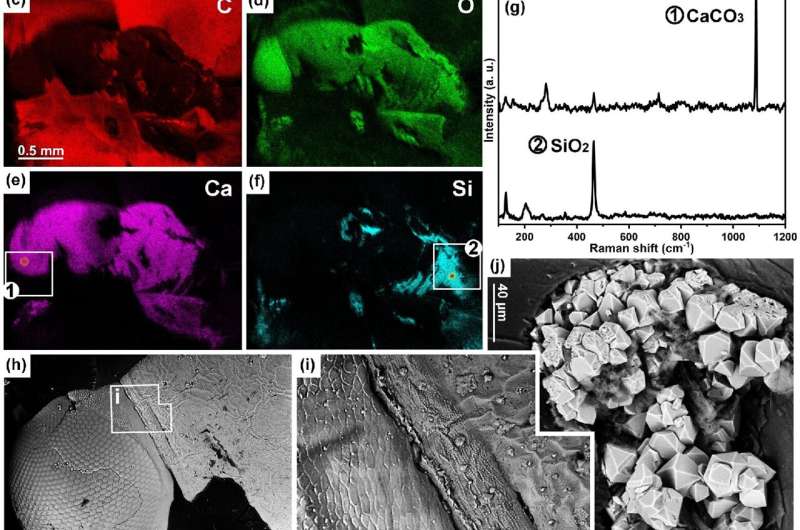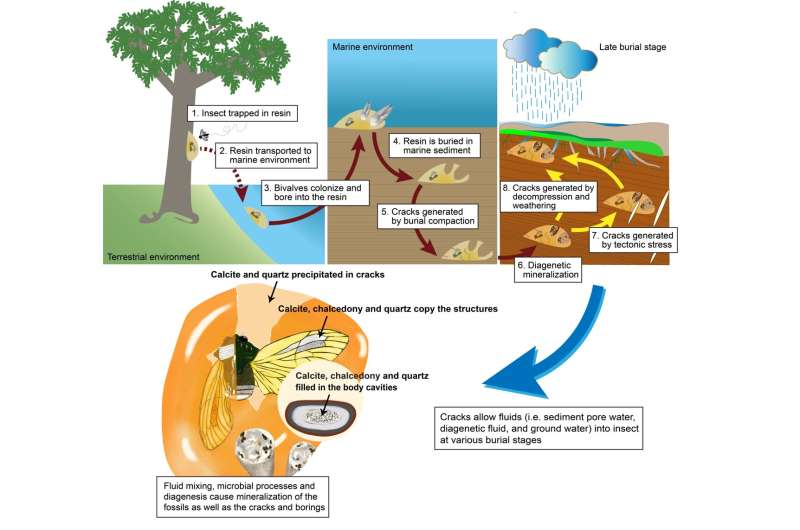Mineralization of amber insects provides new view of amber taphonomy

Inclusions in amber can preserve organisms' organs, tissues and cells in high fidelity, and are known as "exceptionally preserved" fossils.
Amber inclusions are commonly thought to be mummified remains or hollow molds, and the body cavities and walls of the molds are mainly thought to be filled with carbonaceous material. However, this pattern may not apply to all amber inclusions.
Recently, Jiang Hui, the postgraduate supervised by Profs. Wang Bo and Zhang Haichun from Nanjing Institute of Geology and Palaeontology, Chinese Academy of Sciences, along with their collaborators from University of Bonn, Cornell College and other institutions, have proved the widespread mineralization of amber insects in Kachin amber and further reconstructed the taphonomic pathways of mineralized inclusions in amber.
The study was published in Geobiology on Feb. 25.
By opening a few pieces of amber and applying a variety of techniques, the researchers discovered calcification and silicification of insects in amber, which are very rare processes in the insect fossil record.
The analysis showed that the mineralized insects consisted of calcite, microcrystalline quartz and macrocrystalline quartz. These minerals occupied the positions of numerous tissues and substrates, occurring as replacement minerals in organic structures and void-filling cements in cavities within the insects' bodies.
"The preservation of mineralized insects is incredible, with complete calcified compound eyes, exquisite cuticle structures, as well as skin sensillae," said Jiang Hui.
In the silicified specimens, fine body structures such as the trachea and fibrous structures were preserved in the form of microcrystalline quartz, and the body cavities looked like agate geodes.

Insects generally do not have biomineralized tissues made of silica or calcium carbonate.
"The chemical species leading to silicification and calcification of the Kachin insects were considered to come from two sources: decomposition of their tissues in response to microbial respiration and fluid from the surrounding environment," said Prof. Wang Bo.
"Homogeneous minerals in amber inclusions are also precipitated in cracks in the amber matrix surrounding the inclusions. This suggests that the fluid carrying the mineralized reaction species entered the amber along the cracks and then contacted the inclusions," said Prof. Zhang Haichun.
The pyrite in the silicified insect leg may be evidence of microbial sulfate reduction. Other processes like iron reduction and methanogenesis may have also contributed to calcification and silicification. All of these processes generate HCO3- that can react with dissolved Ca2+ to precipitate as calcite.
The dissolved silica may have come from volcanic vents, hydrothermal springs, or clay diagenesis. Kachin amber occurs with volcaniclastic rock, and was preserved in shallow, nearshore depositional environments, where evaporation of seawater may have affected the dissolved silica levels.
Hematite and goethite form in oxidative environments, and they may suggest diagenetic pore fluids that developed during tectonism or ground water that conduced to terrestrial weathering. The presence of organic matter in inclusions may provide reactive interfaces to promote nucleation of silica and calcite films.
This new discovery indicates that mineralization played an important role in the preservation of fossils in Kachin amber, and mineralization in amber is more widespread than commonly thought.
The results demonstrate that resin and amber are not closed systems. Fluids (e.g., sediment pore water, diagenetic fluid, and ground water) at various burial stages may interact with amber throughout its geologic history and affect the preservational quality and fidelity of amber inclusions.
More information: Hui Jiang et al, Widespread mineralization of soft‐bodied insects in Cretaceous amber, Geobiology (2022). DOI: 10.1111/gbi.12488
Provided by Chinese Academy of Sciences




















